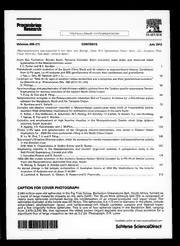
Precambrian Research 2012: Vol 208-211 Index & Table of Contents PDF
Preview Precambrian Research 2012: Vol 208-211 Index & Table of Contents
resee urdh et! http://www.elsevier.com/locate/precamres ELSEVIER Volumes 208-211 CONTENTS July 2012 (Abstracts/contents lists published in Am. Geol. Inst. Bibliogr dstr. Bull. Signaletique; Chem. Abstr.; Curr. Contents; Phys Chem. Earth Sci., Geo Abstr.; Mineral Abstr.) Arctic Bay Formation, Borden Basin, Nunavut (Canada): Basin evolution, black shale, and dissolved metal systematics in the Mesoproterozoic ocean E.C. Turner and B.S. Kamber Precambrian crustal evolution of the South China Block and its relation to supercontinent history: Constraints from U-Pb ages, Lu-Hf isotopes and REE geochemistry of zircons from sandstones and granodiorite J. Yao, L. Shu, M. Santosh and J. Li Comment on “New Ar-Ar ages of southern Indian kimberlites and a lamproite and their geochemical evolution” by Osborne et al. [Precambrian Res. 189 (2011) 91-103] D. Phillips Geochronology and geochemistry of late Archean adakitic plutons from the Taishan granite-greenstone Terrain: Implications for tectonic evoiution of the eastern North China Craton T. Peng, W. Fan and B. Peng Neoproterozoic eclogites in the Paleoproterozoic Ubendian Belt of Tanzania: Evidence for a Pan-African suture between the Bangweulu Block and the Tanzania Craton N. Boniface and V. Schenk Complex calc-alkaline volcanism recorded in Mesoarchaean supracrustal belts north of Frederikshab Isblink, southern West Greenland: Implications for subduction zone processes in the early Earth K. Szilas, J. Elis Hoffmann, A. Schersten, M.T. Rosing, B.F- Windley,T. F Kokfelt, N. Keulen, V.J. van Hinsberg, T. Neraa, R. Frei and C. Miinker Evolution and emplacement of high fluorine rhyolites in the Mesoproterozoic Gawler silicic large igneous province, South Australia A. Agangi, V.S. Kamenetsky and J. McPhie Zircon U-Pb ages and geochemistry of the OQinglong volcano-sedimentary rock series in Eastern Hebei: Implication for ~2500 Ma intra-continental rifting in the North China Craton B. Lv, M. Zhai,T . Li and P. Peng Sub-crustal LVZ below Dharwar craton, India: An evidence for mantle metasomatism and tectonothermal activity in the Archean crust D.M. Mall, K. Chandrakala, A. Sudhir Kumar and D. Sarkar Weathering intensity in the Mesoproterozoic and modern large-river systems: A comparative study in the Belt-Purcell Supergroup, Canada and USA |. Gonzalez-Alvarez and R. Kerrich 1000-580 Ma crustal evolution in the northern Arabian-Nubian Shield revealed by U-Pb-Hf of detrital zircons from late Neoproterozoic sediments (Elat area, Israel) N. Morag, D. Avigad, A. Gerdes and Y. Harlavan An abrupt change in Nd isotopic composition in Australian basins at 1655 Ma: Implications for the tectonic evolution of Australia and its place in NUNA A. Lambeck, K. Barovich, G. Gibson, D. Huston and S. Pisarevsky CAPTION FOR COVER PHOTOGRAPH 3,243 million-year-old spherules in the Fig Tree Group, Barberton Greenstone Belt, South Africa, formed as a result of large meteorite impacts on the early Earth. The 35-cm-thick spherule bed (S3) is composed of nearly pure spherules produced during the condensation of an impact-produced rock vapor cloud. The estimated diameter of the bolide was 20-50 km. The spherules, 0.5-1.5 mm in diameter in the photo, include silica-(clear), phyllosilicate- (gray), and rutile/anatase-rich (black) varieties; massive and layered types; and a few originally hollow spherules. This is one of four spherule layers in the Barderton Belt, ranging from 3,470-3,243 Ma, that represent the oldest known impact deposits and provide direct evidence for a significant flux of large impactors as late as 3.2 Ga. Photograph: D.R. Lowe WAM MO ASvaciliabVlee ronsliene aSt cwwiw.esncicenecDediirrecetc.ctom
